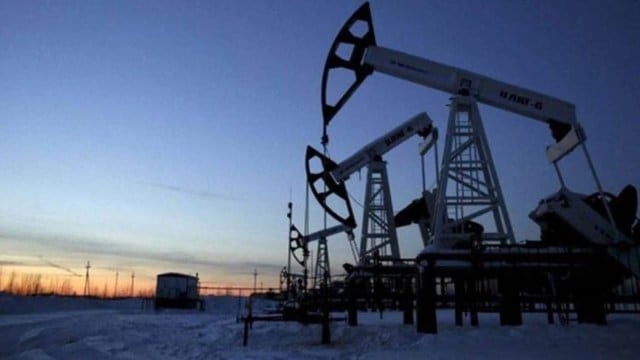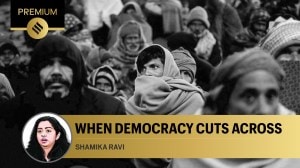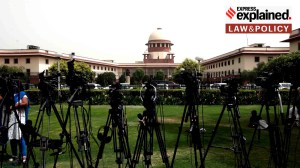Fresh US tariff threat looms over purchase of Russian oil
Russia has been India’s top oil import source during April-December 2024, according to data released by the Ministry of Commerce and Industry.
 Hopes of concession on reciprocal tariffs fade as April 2 deadline nears.
Hopes of concession on reciprocal tariffs fade as April 2 deadline nears.India could attract additional 25 per cent to 50 per cent US tariffs over the purchase of Russian oil, with US President Donald Trump indicating Sunday he was upset at the progress of peace talks with Russian President Vladimir Putin and warning of imposition of secondary tariffs on buyers of Russian oil if he felt Moscow was blocking his efforts to end the war in Ukraine.
India may also not receive a concession on the sweeping US reciprocal tariffs set to be imposed on April 2, as Trump told reporters aboard Air Force One that “all countries” would face the new tariffs. This comes even as the US and India concluded their four-day talks on Saturday to determine the contours of a trade agreement.
Russia has been India’s top oil import source during April-December 2024, according to data released by the Ministry of Commerce and Industry.
Sources in India’s refining sector indicated that more clarity was needed on what exactly the US would do and whether there would be any scope for exemptions if Trump were to follow through on his threat of additional tariffs. “It is difficult to say how this will pan out. We need more clarity on what he (Trump) meant when he spoke about potential tariffs on buyers of Russian crude. Will it be limited to tariffs, or would it involve possible secondary sanctions on buyers? That is also a critical question,” said an industry source.
India’s Russian oil imports have averaged 1.85 million barrels per day (bpd) in the first 21 days of March, sharply higher than February’s 1.47 million bpd and January’s 1.64 million bpd, according to provisional data from commodity market analytics firm Kpler.
Global prices may rise
IF RUSSIAN OIL were to be priced out from the market, it could lead to higher global oil prices. While securing sufficient oil supplies over the medium term should not be an issue for India, higher oil prices and the loss of discounted Russian barrels, would be a setback for the country.
So far, the Indian government and refiners have been clear they will not buy any oil that is under sanctions or involves sanctioned third parties. India has not purchased crude from Iran for years due to US sanctions. Even Venezuelan crude that was coming to India was through sanction exemptions granted by the US to certain oil companies.
‘India may have to halt Russian oil purchases’
Industry watchers and analysts, at least for the time being, are not bracing for the full impact of Trump’s tariff threats. The US President has been mercurial in his tariff threats since taking office in January, but despite his threats to Russia — the world’s second-largest oil exporter — global oil prices have not seen a sharp rise.
However, if the White House proceeds with imposing tariffs on buyers of Russian oil or enforces secondary sanctions, Indian refiners are likely to halt their purchases of Russian crude, which currently holds the largest share in India’s oil import basket at over 30 per cent.
In such an event, they would most likely turn to their traditional suppliers in West Asia, such as Iraq, Saudi Arabia, and the United Arab Emirates (UAE). While Indian refiners may be forced to scramble for alternative suppliers in the short term, oil supplies over the medium term are expected to stabilise.
Oil tops the list of India’s merchandise imports by value, and oil prices impact various aspects of the country’s economy. “It is extremely unlikely that Indian refiners will persist with Russian crude imports if the US imposes tariffs. A quick shift to suppliers like Saudi Arabia and Iraq is likely to replace the lost Russian oil volumes,” said an oil sector analyst.
US open to a deal on reciprocal tariffs
Trump said that the US is open to negotiations on reciprocal tariffs but that “those pacts” would have to be discussed after the reciprocal tariffs go live on April 2. The Indian Express reported last week that US negotiators did not divulge any details of the reciprocal tariffs to the Indian side during trade talks.
Trump’s clarification that all countries will face reciprocal tariffs follows remarks from White House economic adviser Kevin Hassett, who told Fox Business that the measures would be heavily focused on 10 to 15 countries that account for the bulk of the US trade deficit.
“There are more than 100 countries that don’t really have any tariffs on us and don’t have any non-tariff barriers,” Hassett said, according to Reuters.
Despite hopes within Indian industry for a resolution on reciprocal tariffs, Indian and US negotiators have yet to agree on the terms of reference (ToR) outlining the scope of the deal. While talks remain in their early stages, the delay in finalising the ToR indicates that both countries are not yet on the same page to begin formal negotiations on a bilateral trade agreement (BTA), experts said.
The Indian Express had also reported that Indian negotiators are concerned the US could use reciprocal tariffs as leverage to push for an early deal on goods, particularly regarding market access for American products in India, such as automobiles, whisky, and agricultural products.
Must Read
Buzzing Now
Apr 03: Latest News
- 01
- 02
- 03
- 04
- 05

























